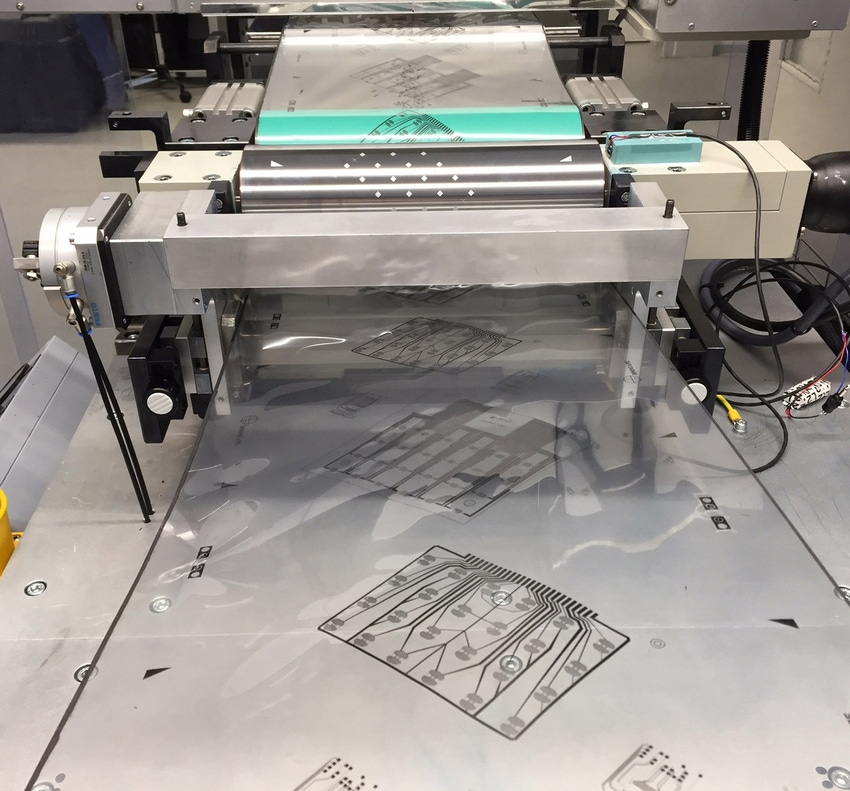Graphene Bio-Compatible Sensors Printed with Ease
Researchers at Fraunhofer Institute have developed a new method to easily print graphene-based bio-compatible sensors for scientific and medical use.
May 14, 2018

Scientific and medical research is eying the use of cell-based biosensors to perform internal functions that used to be done by other means, such as medications. In the past, these sensors were expensive and complex to develop, which kept them from reaching their potential for widespread scientific and medical use. Now, researchers at the Fraunhofer Institute in Germany have developed a method to easily print graphene-based bio-compatible sensors.
In fact, scientists at the Fraunhofer Institute for Biomedical Engineering IBMT have already partnered with the M-era.Net industry project BIOGRAPHY to develop a prototype for cost-effective mass production of these biosensors using a roll-to-roll printing process, they said.
"Our system prototype can print about 400 biosensors per minute on a continuous foil," said Dr. Thomas Velten, head of the Biomedical Microsystems Department at IBMT and project manager of BIOGRAPHY. IBMT scientists designed the process, while industry partners provided the printing equipment and graphene ink used for manufacturing.
|
Researchers at Fraunhofer have developed a roll-to-roll process that can produce film with printed biosensors. (Image source: Fraunhofer IBTM) |
Cell-based biosensors can simulate the effect of various substances, such as drugs, on the human body in the laboratory. They work by measuring changes in cell cultures via electrical signals using electrodes mounted inside the Petri dish or the wells of a so-called well plate.
Researchers can use these biosensors to test, for example, the effect of vaccines or drugs. If added viruses destroy a continuous cell layer on the electrodes, the electrical resistance measured between the electrodes is reduced. If the active ingredient is effective, the number of cells that are destroyed by the viruses will be smaller. The measured resistance change also will be lower as a result.
Biosensors also can test for toxicity in cosmetic processes by using the same principle, researchers said. This use of the sensors can replace the testing on animals that is still being done for this purpose.
Why Now?
Historically, developing these biosensors has been expensive and complex for a number of reasons. One is that the electrodes are made of a biocompatible and electrically conductive material, such as gold or platinum, which is not easy to come by and thus expensive. The production of microelectrodes also requires a complicated lithographic process, researchers said.
To cut down the cost and complexity, Fraunhofer researchers took several approaches. For example, they replaced the precious metals typically used for electrodes with graphene, which is highly electrically conductive, biocompatible, and—if in the form of an ink—can be printed on surfaces.
Researchers had to develop a combination of inks comprising graphene and protein and pay careful attention to various aspects of the process for it to work, Velten said. "In particular, it is crucial to adjust parameters, such as the ink viscosity, printing speed, doctor blade pressure—a doctor blade wipes off excess ink—and well depth of the printing cylinder, so that the printed structures correspond to the nominal dimensions," he said. "It’s only thanks to the proteins that the cells adhere well enough to the electrode foil.”
READ ABOUT SIMILAR DEVELOPMENTS HERE:
Other challenges included adapting the surface energies of the foil and ink for optimal transfer of the ink from the printing cylinder to the foil, Velten said. Because the proteins do not tolerate solvents or high temperatures, researchers need to carefully mix the ink ingredients and drying method to ensure that the ink could dry quickly enough.
Now that researchers have developed a prototype process, they aim to engage in practical tests of the printed biosensors on their way to commercialization of the platform, Velten said. "We expect to be able to offer the industry a universal technology platform in no later than a year.”
Elizabeth Montalbano is a freelance writer who has written about technology and culture for 20 years. She has lived and worked as a professional journalist in Phoenix, San Francisco, and New York City. In her free time, she enjoys surfing, traveling, music, yoga, and cooking. She currently resides in a village on the southwest coast of Portugal.
2017 Call for Speakers INSPIRE. COLLABORATE. INNOVATE.Atlantic Design & Manufacturing, part of the largest advanced design and manufacturing industry event on the East Coast, is the annual must-attend trade show for discovering the latest in design engineering. Source from the region's most comprehensive collection of cutting-edge suppliers, deepen your expertise with free, conference-level education, and network with thousands of professionals who can help you advance your projects — and your career. From prototyping to full-scale production, one lap of the show floor will help you overcome your toughest manufacturing challenges and keep you up to speed on innovations transforming the industry. Everything you need to take projects to market faster and more cost effectively is here. |
About the Author(s)
You May Also Like





